Interview 073 • Oct 24th 2019
- Interview by Lou Noble, Portraits of Elinor Carucci by Chris Buck
About Elinor Carucci: Midlife
Born 1971 in Jerusalem, Israel, Elinor Carucci graduated in 1995 from Bezalel Academy of Arts and Design with a degree in photography, and moved to New York that same year. In a relatively short amount of time, her work has been included in an impressive amount of solo and group exhibitions worldwide, solo shows include Edwynn Houk gallery, Fifty One Fine Art Gallery, James Hyman and Gagosian Gallery, London among others and group show include The Museum of Modern Art New York and The Photographers' Gallery, London.
Her photographs are included in the collections of The Museum of Modern Art New York, the Brooklyn Museum of Art, Houston Museum of Fine Art, among others and her work appeared in The New York Times Magazine, The New Yorker, Details, New York Magazine, W, Aperture, ARTnews and many more publications.
Links
Foreword
When we heard Elinor Carucci was putting out a new book, we knew we'd have to interview her again. Her work is staggering in the way it deals with and interrogates intimacy, and this book far surpassed our expectations. It made us laugh, made us uncomfortable, made us consider our own relationships with those close to us who themselves are in the middle of their lives. We would call it brave, but for Elinor, it is simply who she is.
This interview has been edited for length and clarity.
Interview
All images from Midlife courtesy The Monacelli Press and Edwynn Houk Gallery
⁂
So, how does it feel to be done with the book?
Now, I don’t know!
Ha!
I mean, it feels like a mixture of being nervous and being excited. Like every artist, I want my work to do well, I want people to relate to it. I want people to really feel it. So I just hope it will happen.
Do you feel finished, like there was still work you wanted to put in there?
So this is the fun thing. I felt finished, and then I started looking for a publisher and then Alan Rapp (editor of Carucci’s book, Closer) and I started working on the book, and finalizing it and I suddenly had a bit of a difficult time, I was like, “is this a midlife difficulty? Ohmigod, am I still in my midlife?”
Haha!
So you know it’s hard, the way that I work is very organic and it comes from my life, so some things are very clear. Photographing pregnancy, it begins and then it ends, but some things are more obscure. Even when I was researching Midlife, different websites, different books gives you different definitions, it can be a 20-year stretch, and it’s different for women. So I guess I’m finished. I have no choice, and if I have a little bit of good or bad things, then I have to relate it to some other thing and not to my midlife time.
Do you ever feel a hesitation in showing such intimate moments?
No. Haha!
Was that something you had to work at or has it always been that way?
I think it’s me. When I was growing up, I was kind of the class clown and I was always making fun of things in my body or things that are happening to me. There was always a need to draw some attention to me. There is a little bit of the narcissism of it, but there is also the elemental, it was in many ways how I connected to a lot of people. I talked about my flaws in a funny way, or I make fun of myself when I was a teenager, and then people open up to me and I realized how much of what I’m feeling is universal. Back then I was a teenager, so it was relating to the different age, but I think it’s something I always did in different ways, whether it was comic or not, but that was brought into my work. So it’s very difficult to live the life of an artist, very difficult. I can talk about it for 7 hours if you want.
Please!
Okay! But to make those pictures and show them…people tell me, you’re brave, but I mean, this is my voice, this is how I reach out to the world, this is how I ask for acceptance and give acceptance, as well, so…
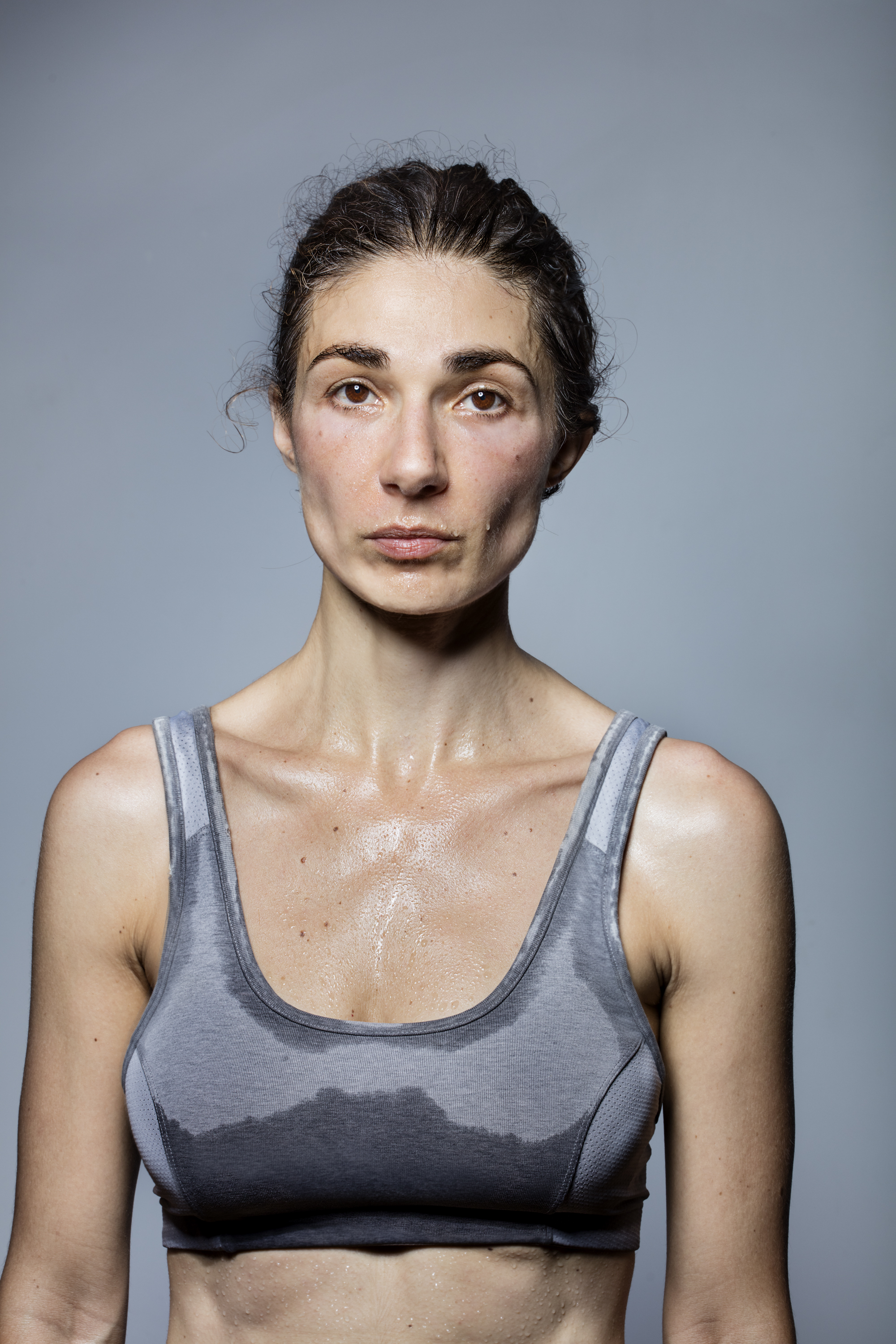
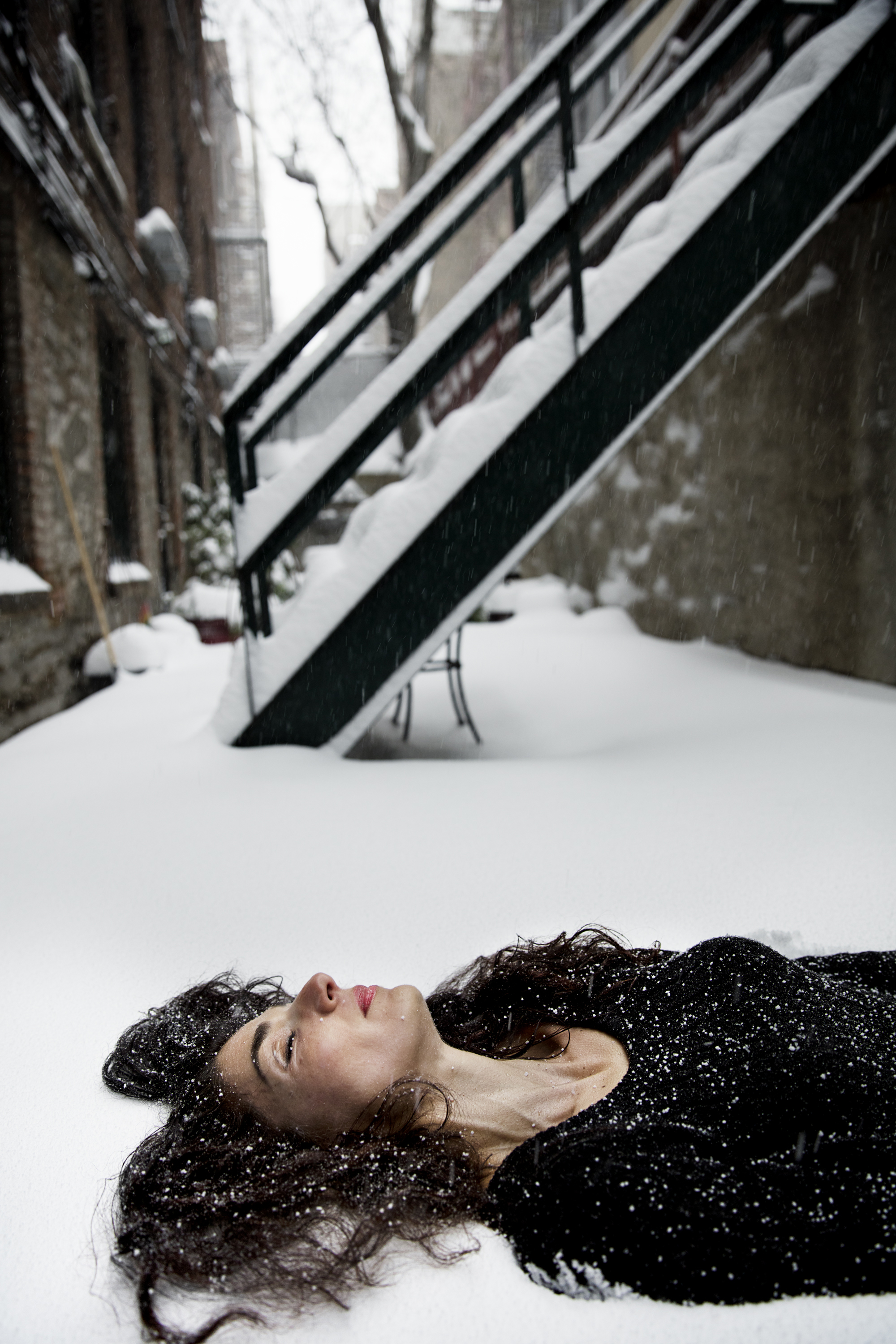
Left: Workout, 2016
Right: Winter, 2016
One of the photos that jumped out at me was the one of you and your son, with the caption, “how long can I hug my son nude?” What are you trying to investigate with that idea?
As a Jewish Mama, I’m trying to make him feel guilty and hug me and do it forever!
Ha!
It’s difficult. It was two things, and this is something that’s been happening also in Mother, in the previous book, where I put into my work things that I feel and experience, but also things I’ve been going through.
As a mother and in Midlife, it was a lot of what I heard from other mothers and it became, for me, that this is really a part of our age, and with children in general, when do you get to the time where they’re physically, and not only physically, when you are shut down from a lot of what they’re going through socially and personally, but also when you know, you can’t hug them anymore. You can’t see them naked, you can’t kiss them on the lips. You can’t kiss them at all!
Mmhm.
And I had this conversation with many mothers, all around my age and their midlife and they’re like, “I think I have another year!” It’s so funny and painful at the same time. And I think I have a year-and-a-half, or maybe a year and seven months and I was like, “oh my God,” and it’s also how I felt so I’m trying to take this and my own experience and put it into the work. I mean life is a constant chain of losses, I guess.
Ha, yeah.
I know, I sound terrible. There will be a point where your baby that you breast-fed, you wouldn’t be able to hug them, if you’re naked. And some of that physicality and closeness that you have with children will go away, not only sons, but with sons I think there is something there where they have to, and also it will be good for them to separate from you and and to put some boundaries between their sensuality and their mom, and that’s painful!
Have their thoughts about your photography changed as they got older?
For them, it’s just a part of me. So they don’t think about my photography in a critical way. Is it good, is it not, is it interesting; it’s just mom. This is what she does. And so I think as they get older, they’re more intellectual and critical but it’s a package deal, me and my work. So I think they think about it as just another aspect of their mom.
I was talking to my daughter. I was arguing that my husband is weirder than me. And then my daughter said, “mom just go to your website!” Haha!

Three Generations, 2016
Haha! Are they still as willing to be involved or are they more hesitant to participate?
They are willing to be involved. They don’t always have the patience sometimes or I get on their nerves or they always put different limits on it, even on when they were five or ten. So they do sometimes tell me, “mom not now,” and, “this is annoying,” but they do let me photograph them, which is amazing.
I guess you raised them to do it. They don’t know that they can say no!
Thank you very much, thank you for complimenting me training the circus animals! It’s very tricky now because they are teenagers, and teenagers want to own their identity, their sexuality, it’s theirs, and a lot of the elements in their lives are, you know, are now out of my world. It’s theirs, it’s private. They have their personas and lives and socialize, and I’m trying to photograph that, as well. So it’s challenging and it’s very different than we were all younger, like in Mother when we were in the bubble of them and me, almost as one unit as it fell to me. So it is very different now and it requires me getting to know their social circles more and getting, being accepted there.
The worst thing you can try to do as a parent is try to be cool. I even learned how to twerk, haha!
Haha!
So it requires a lot, and it’s challenging. It’s challenging and I have to watch, and not to let myself ask for too much or push too much. It’s who they are that I want to photograph and that is so interesting and inspiring, but it’s exactly the same thing that is sometimes, you know shouting me off and saying, “mom, this is off limits.”
The boundaries.
Their boundaries, their personalities, they now have different facades, you know, who they are at school, who they are with their teachers, who they are with their friends, or when they’re going out to a party. I want to photograph all of it. All of it. Even though I know I can’t.
Yeah, they don’t want to see you show up at the party.
Yeah, I’m trying to negotiate this one hard. Yes.
“Mom, what are you doing here?”
I’ll just come for ten minutes!
HA! Was there anything you discovered in the process of putting the book together that you didn’t realize beforehand?
I discovered that I was creating a Midlife project halfway through, so the discovery was also, “oh this is the blood paintings and the generation things, and all those things that I felt were like different series. They’re all actually one body of work.” They are my middle ages, they’re my midlife time. So that was, that was a little different than working on Mother, where I got pregnant, I gave birth, now I’m a mother, that was more clear, it was the time of early motherhood and childhood
Right.
This was tricky to describe in a body of work because it’s just much more obscure, and then it took me a while to understand that I’m working on this project.
I was very affected by it, which doesn’t happen with me and most photo books. They don’t come together as a series in the way this one does, where I really get a good sense of the kind of different facets that you’re trying to convey.
Thank you, that means a lot to me, really.
Yeah, and because I didn’t know that the red sections were blood until the end. It felt like a twist, lent it a more visceral quality. Did you did you intend to have people find that out at the end and then have to go through it again?
No, not at all. Now that you’re saying it, it’s the first time, I swear to God, that I’m thinking that people want to immediately understand that these are blood.
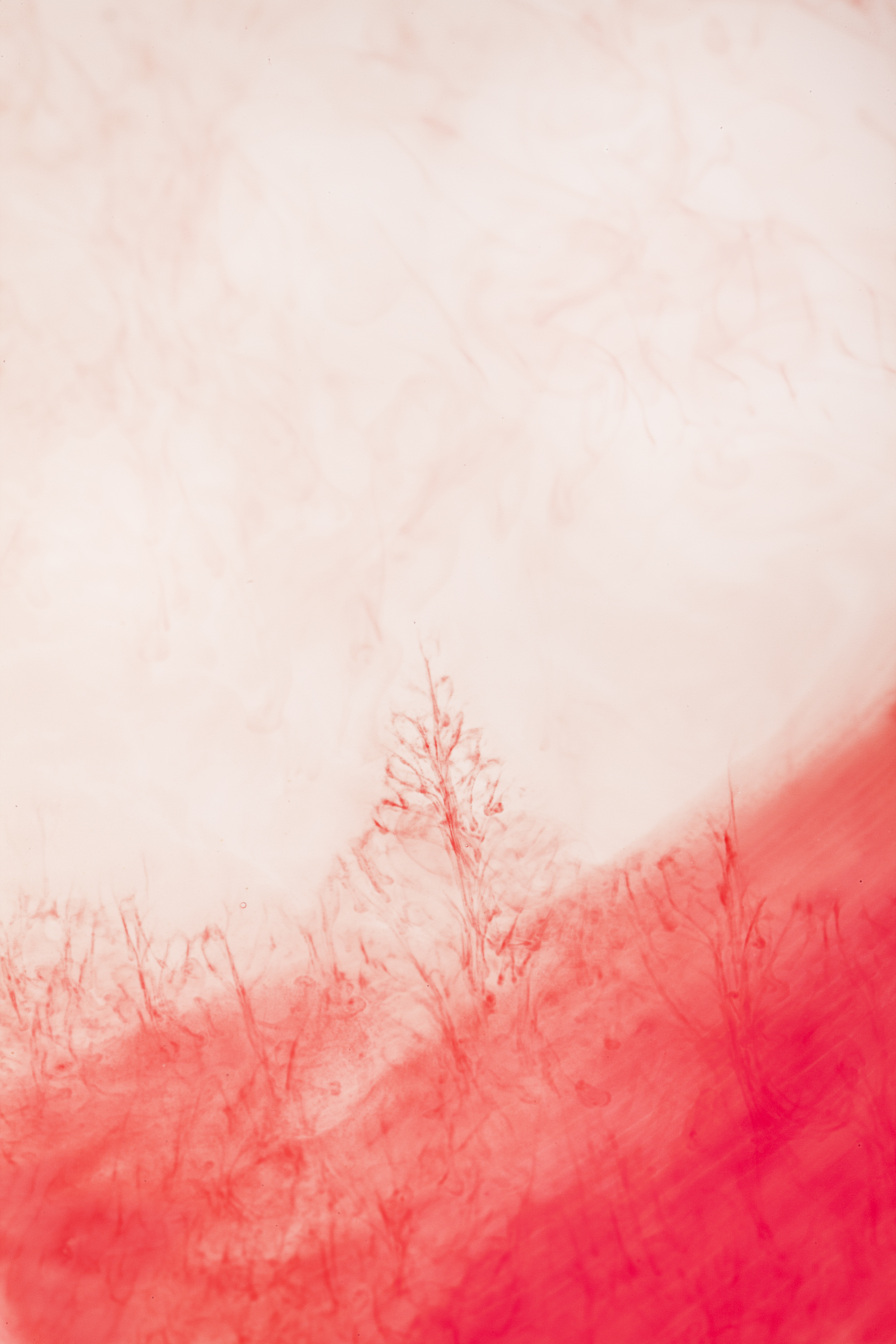
Red 1, 2014
But it worked for me in that the images on their own are interesting and they seem to work as a breather between the next series of images, and then discovering at the end what those breaks added something for me, tied it all together.
I also didn’t mean to put my text at the end. Alan Rapp, my editor, it was his decision. And I was like, “really?” Because I thought it would make sense reading about it and then seeing the work. So it was his decision. He was like, “let’s make it an afterword” and I was eventually just like, okay, and then you have Kristen’s essay in the beginning and then mine at the end. So I didn’t think about this decision until later on.
I had a feeling when Alan said, first of all he’s really smart, he fought to get my first book published, Closer. I’m talking about the late 90s, so I know he gets my work and he’s known it for twenty years, now. So it did make sense. I think there is always the artist’s anxiety that you want to be understood and you want to lead the viewers, but when he said it, I was like, “okay, that could work.” And it can be a more of a personal experience going through the images before you get some information.
Were there any images you were hesitant about, or on the fence about putting in the book that made it in?
Yes. Yes, there were some. I was struggling with the dead bird picture. I wasn’t sure…of course, aging, and there is something morbid about the work and thinking about aging and death and loss, but I was hesitant about this image. I wasn’t sure, and Alan was like, “I think it makes sense,” because it was something, I mean, first of all I was thinking about Sally Mann, and she’s a big influence to me. I was just drawn to photograph it when I saw it and I photographed it. It’s not typical for me, you know.
I was thinking about her work and, maybe it’s in her work all along, but the death theme did appear when she was in her midlife, the corpses in the farms that she photographed, and then she was also talking about her dog dying and then other things that happened, but it helped me to take this decision and I was like, “yeah, I guess that’s, that’s the time where death kind of makes an entry to my work.” But I was struggling with this one.
Yeah, the book doesn’t feel morbid.
Yeah, it doesn’t feel morbid.
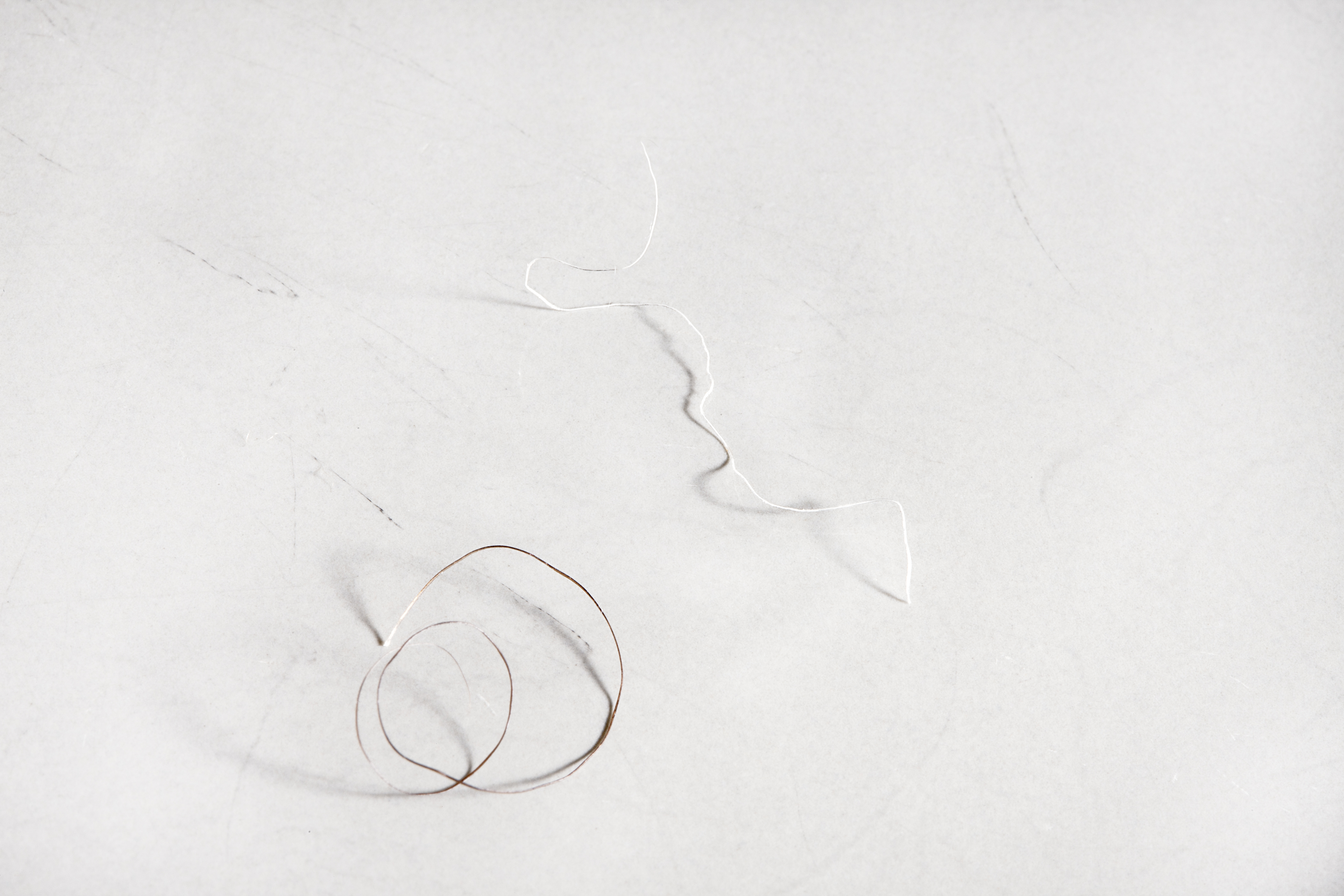
Two Pubic Hair: One Brown, One Grey, 2014
But having that in there, you don’t want to ignore that quality of aging, so it does give that quality its due, but death is something that’s coming, it is an aspect of aging.
Every day you’re closer!
But it also feels like it’s looking forward, as well. That once you understand this part of your life, it allows you to continue on and not be stuck not understanding where you are.
It’s true, and also there is a lot of beauty to this age that I’m describing or photographing, from the deep friendship I have with Eran, the different relationship with my mom, and there is a picture there called “Mother’s Being Crazy.”
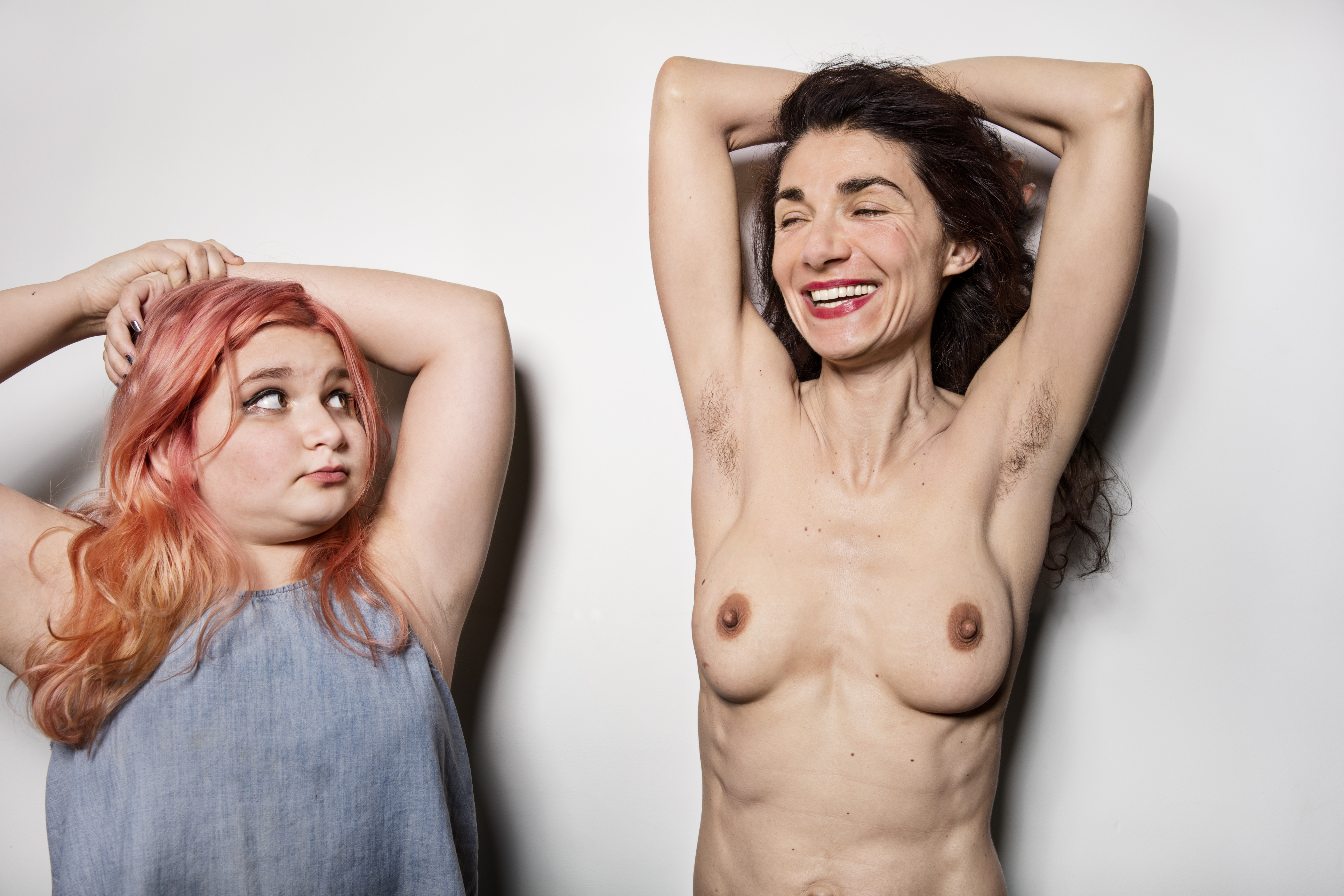
Mom is being crazy, 2017
Yeah!
That is very much a part of midlife, part of just getting older and speaking your mind and not feeling like you have to fit in or you have to do this or that, you’re just becoming more and more you. To the point where sometimes the kids refer to it as, “Mommy you’re weird, you’re crazy!”
Haha!
No, I’m just living my life even if I’m…my kids, we had this argument where I’ll see little kids and I will talk to them or give them a hand, and they’re like, “mom you’re being crazy,” and I say to them, “I’m not crazy. I’m just a normal human being who loves the world today.”
You’re unbound, you’re at a point where you can just be who you want to be without having to worry about stuff…
More and more. And I remember seeing things like interviews with Agnes Martin, and it’s also personality of course, but she was just a hundred percent brutally honest, speaking her mind and when I met her to photograph her, she was in her nineties, and I remember thinking, “this is who she is, but it’s also something that comes with age, where you get to the point when you are older than middle age where you just really don’t give a fuck.”
Hahaha!
And we refer to it as crazy, but it’s not, it’s not crazy, necessarily. It’s kind of self-acceptance and honesty, and in my case, I feel it’s also a way to connect to the world and if I let myself do it more now, it’s maybe because I feel like I have no less time than I had ten or twenty or thirty years ago, and I just want to connect and feel and see and love.
Yeah. One question that jumped at me when I was looking at the book: how did you get the uterus shot?
It was really really challenging to photograph it, more than I thought originally, because I spoke to my surgeon before the surgery and gave her Mother, so she understands why I want to photograph, and she said that she will keep the uterus for me so I can photograph it before I leave. But then, after a three or four-hour anesthesia, I woke up because my husband was in my face telling me, “they’re taking your uterus away, you have to take a picture now.”
I came to the hospital with the gear, with the strobes and the cars and the lenses and everything, but the people in the hospital, which I’m not criticizing, you know, the lawsuit culture in America, they got really nervous about the uterus hanging out there! So they started to argue with my surgeon, and they were like, “just take a picture with your cell phone for her.”
Haha!
She’s explaining to them that I’m an artist. So my husband saw that I was up…now, I just had major surgery and I’m nauseous and in some pain and he’s in my face, like, “they’re taking your uterus away! You’ve got to take the picture now!” And he’s opening the strobes because he’s been assisting me for years, it’s such a comic situation, then my surgeon saw that I was up, so she’s running to me, almost running, walking really fast and then she’s like, “here!” She’s up, with my uterus in plastic bucket. Now, I walked into the hospital sobbing, it was really difficult for me.
Of course.
So I’m waking up and now I am forced to, I mean, I brought it on myself, and I could laugh about it only a few weeks later because it’s really like…
Traumatic.
But it’s comedic, she’s running to me, and she placed it by my bed and I took my favorite 28mm lens, but it had no autofocus and I was so nauseous, I remember trying to focus and I took a few pictures and then she took it away, so it was difficult, the whole situation and to get it done and the gear and the light and emotionally to see it there. It was not it was not an easy one to make.
So that’s the story of that day!
Why did you have a hysterectomy?
I had massive bleeding, which is something my mom has as well. I had fibroids, and then I was medicated for awhile, every time I had my period I would take this medication, but then the medication stopped working and it was just I had one episode that was scary. It was dangerous. So I had to have it.
How do you feel about the image now?
How do I feel right now, I’m happy it exists. But it’s different. I think I even have a different relationship to my work than in the past, where some of it is difficult and usually making an image was more therapeutic, there was something positive that it gave me.
And this body of work for the first time, some images…I’m committed to the image, you know, I stand behind this image. It’s important for me to do it and to put it out in the world and it’s part of something difficult that I went through, and I was shocked to discover how common it is to go through a hysterectomy. I was shocked, so even discovering those numbers, I was even more like, “this image is important for me and I want to put it out there,” but it saddens me to see it. I’m not like ooh!
Oh my uterus, adorable!
Yes, so it’s more complex, my relationship to this image.
Are there other images in this book that are also difficult for you in that way?
Yes, so some images are difficult for me to look at, there doesn’t have to be anything as dramatic as the uterus, it’s just like seeing that my mom aged.
Yeah.
She’s beautiful and I love her, but she aged, and I think this is very true for all of us. I mean most people won’t photograph their uterus there in the hospital, but you know when we just look at snapshots that we took with our phones of our parents, and you’ve suddenly realized that they age.
I remember when I had my hysterectomy, and my mom said, “I can’t believe she was focused on her experience, I can’t believe I have a daughter who is going through a hysterectomy.” So it was a reflection on her and I think some of what the photos reflect are more difficult to accept. And women, especially after a certain age, it’s hard for us to look at pictures. I mean, it’s hard. A lot of times women that are a little older, women in general, I think, are more judgmental about their looks and as we get older it’s harder for us to see ourselves in pictures. You always say, “oh I look so old in this picture.” That’s how I feel many times. I look at a picture like, “who is this?” It’s me, and that’s how I look, but we feel like twenty-five forever, there’s a gap between how we feel and the image of us that is growing with age.
And it makes it difficult, for professional photographers or the rest of us.
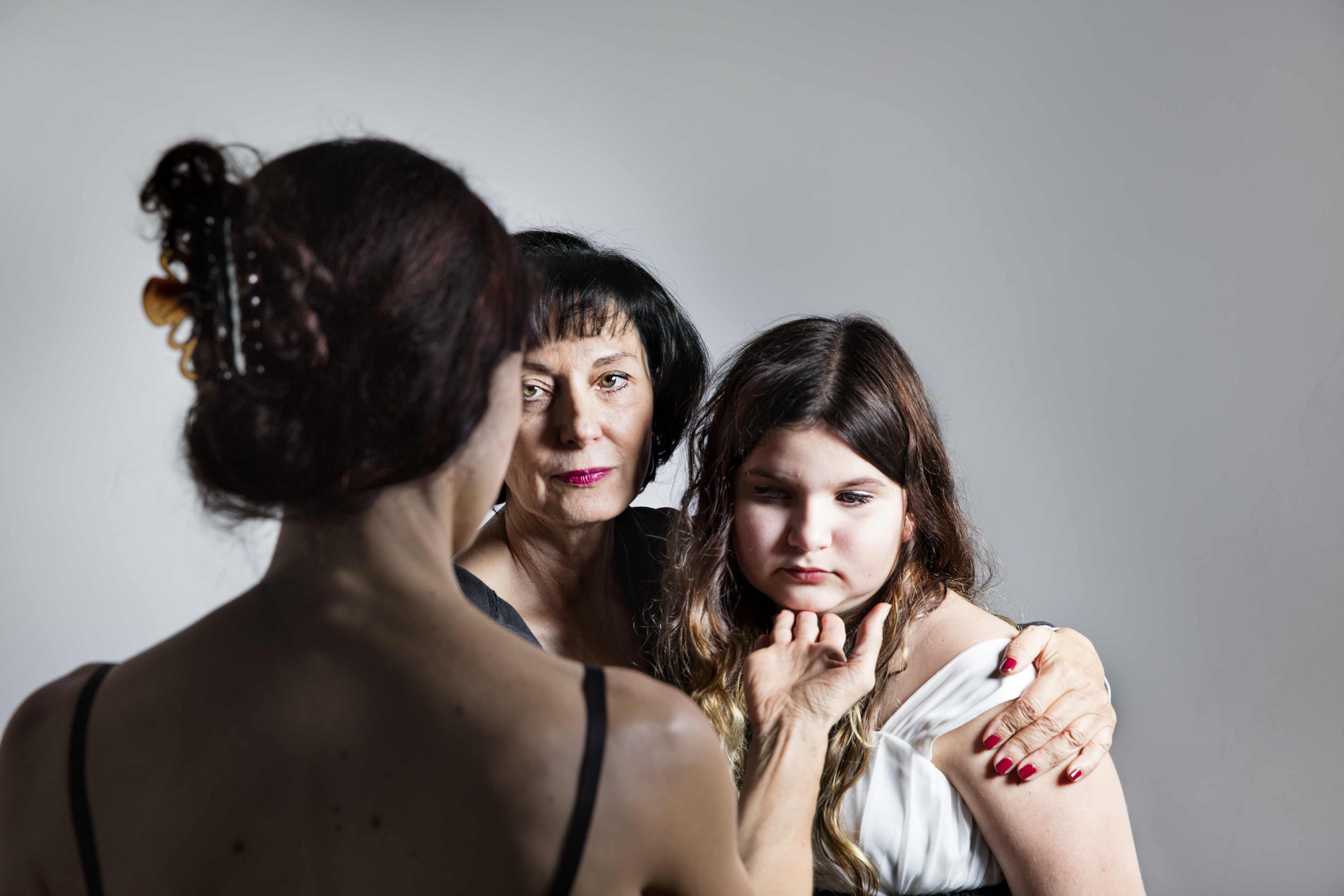
My Mother Wants Me to Forgive My Daughter, 2016
Did any feelings come up as you were putting the book together on how your children had aged?
It’s kind of a comfort, in a really weird way. I feel that I’m aging, that my mother is aging, and my father is aging, and Eran is aging, but that they’re growing out to the world. It’s sad that I have to let them go out to the world eventually, that’s hard for me. But there is something about youth that is beautiful and comforting for me as a middle-aged woman, and making me optimistic. So if anything it’s a comfort.
Somehow, that they’re finding the ways, and to see their personalities blossoming, coming out, who they are. It helps me accept my aging because it’s so beautiful and inspiring.
Right, because they’re not aging yet. They’re just growing up.
Exactly. They’re growing into who they will be, discovering who they are, and all the opportunities are open. It’s really something beautiful.
One thing that I found very interesting was in the afterword, you allude to another person. In the relationship between you and Eran, there are two lines about another lover.
Right.
What led to putting that in the afterword? I don’t really see it in the photos themselves.
Oh no, but it does exist in a series that is not in any of my books, but it’s on my website, and it’s called Crisis. I should one day publish it, because it’s coming up, some people ask about it, students, and I don’t know why I didn’t, maybe because it wasn’t a body of work.
It was a shorter series, and it’s a time in our lives back before we had kids, where we almost divorced, Eran moved out. He was, I felt, neglecting me in some ways, and I had some back pain and my grandma was diagnosed with ALS. It was just a difficult time in my life. And eventually I had an affair with another man. And it was a big crisis in our marriage, and Eran moved out, but eventually we got over it, and got back together. And this experience is a big big part of who I am, and also it was over a year, a year and a half, a really difficult time and it’s a big part of a relationship.
Right.
We put it to bed and how we managed to get over it, because I did love this other man, and I did love Eran, as well, it’s not like I stopped loving him. So we got to see each other’s ugliest sides. And we’re still together and love each other, that was a big maturing experience.
So you can see, if you look at Crisis, some of the images are there and Eran, throughout Crisis, encouraged me to take pictures and I remember even at some point, he said, “just make sure you also photograph yourself with him.”
Oh wow.
And it was such an unselfish thing to do, to say, that I think it made me love him in the middle of this crisis! Like, this is so beautiful and so rare that in the middle of all this, and ugly things were being said, he was yelling at me and saying some you know, angry things, and then he’s saying, “by the way, make sure you also photograph this part of your life that I am not a part of,” and you know, mainly what I was thinking is, “I guess he still loves me.” Because when you’re in the middle of difficulty, sometimes you think your partner hates you.
It’s not how you feel about them. It’s all covered in all the mess of the fight, or the crisis, or, and I think after that I was thinking, maybe he really loves me if he’s thinking that, so I think it’s there just because it was a part of me and it’s a part of us and it’s a part of my womanhood or who I am as a woman.
And the way that I write is over the years, I just put in my phone different things, because then if I have to sit down and write an essay for my work, I’ll be freaking out and I’ll have nothing in my brain. So I remember the red…when I started making those blood paintings and I was like, “what it is about seeing blood, seeing a lot of blood for women, the change that that’s making”, and just the color red, for me and for women, and one of the things that came to my mind was the flowers that I got from this other man. And so I just, I just made a list, you know.
Right.
And then I was thinking about my mother’s lipstick, my mother’s nails, my nails, blood, period, the flowers Richard sent me, this this and this. And then it was there in my intuitive list.
The whole book is so intimate it almost feels uncomfortable to be viewing another person’s life this deeply.
Good!
Ha! I’m really impressed with the book because of that.
I think it is exactly this quality…there are people that don’t relate to my work, or the genre, some people, it makes them feel uncomfortable, and Kristen wrote a little bit about that in her introduction, that making the viewer feel uncomfortable and bringing them closer to seeing things and thinking about things. And it’s part of who I am.
You know, I want to make a living, I want the gallery to show my work because they sell prints and all those practicalities, but at the end of the day, I say something from the very bottom of my heart and I’m like, this is how I say it.
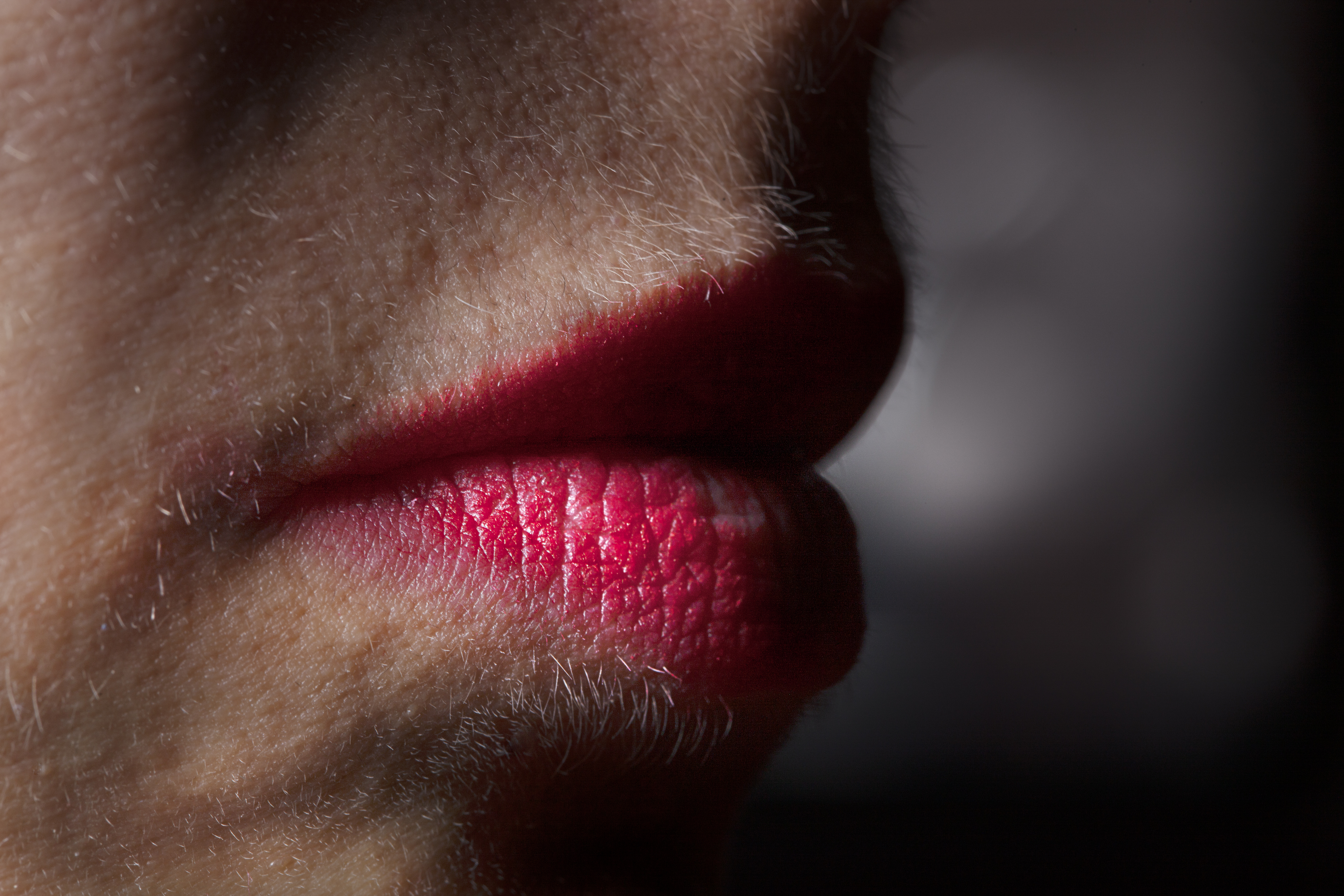
Lipstick and Facial Hair, 2014